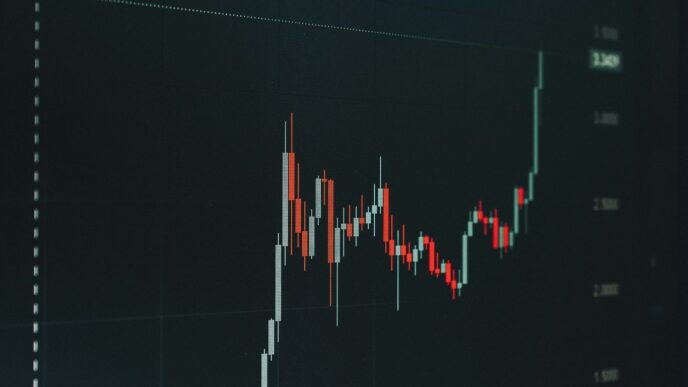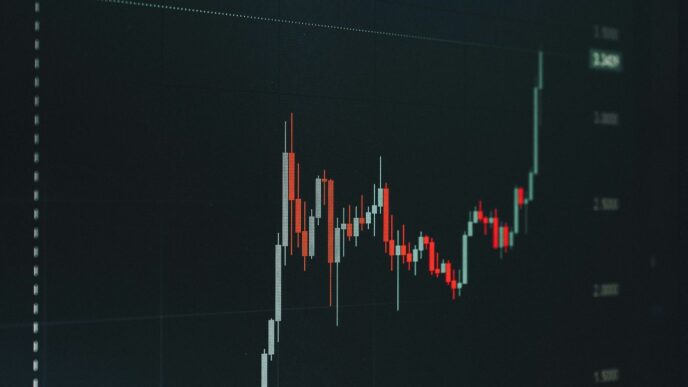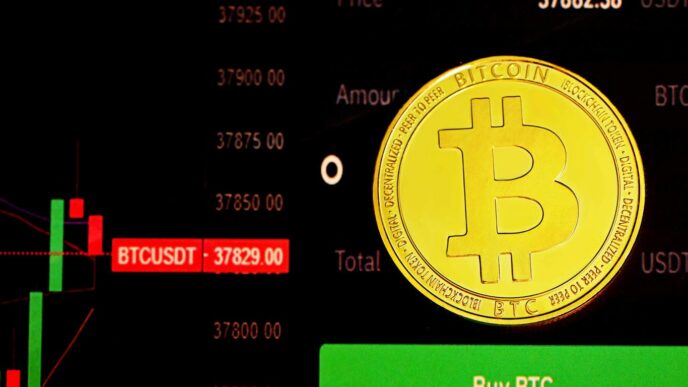So, you’re looking to get a better handle on the crypto market? Forget just staring at price charts all day. There’s a whole other world of information right there on the blockchain itself. It’s called on-chain data, and it can tell you a lot about what’s really going on. Think of it like seeing the money flow, who’s holding what, and if people are actually using the networks. This guide will break down what these on chain metrics are all about and how you can use them to make smarter moves.
Key Takeaways
- On-chain data offers a transparent look at crypto transactions and network activity, unlike opaque traditional markets.
- Core on-chain metrics like active addresses and transaction volume help gauge network use and value flow.
- Advanced indicators such as TVL and MVRV provide deeper insights into DeFi health and market valuation.
- Analyzing on-chain data can help spot patterns like accumulation, distribution, and potential market turning points.
- Tools like Dune Analytics, DeFi Llama, and Glassnode are vital for visualizing and interpreting on-chain metrics.
Understanding The Fundamentals Of On-Chain Data
So, you’re probably hearing a lot about "on-chain data" these days in the crypto world. It sounds fancy, but really, it’s just about looking at the actual transactions happening on a blockchain. Think of it like this: a blockchain is basically a giant, public spreadsheet that everyone can see. Every time someone sends crypto, or a smart contract does something, it gets written down in that spreadsheet, and it stays there forever. That’s the "on-chain" part. It’s all out in the open.
Now, why is this even a thing? Well, it’s different from "off-chain" stuff. Off-chain is like when you and your buddy Venmo each other money. It happens, but it’s not recorded on a public ledger for everyone to see. Crypto transactions, on the other hand, are like a public announcement. This transparency is a big deal because it lets us see what’s really going on with the money and the network itself. It’s like having a backstage pass to the entire crypto economy.
On-Chain Versus Off-Chain Transactions
Let’s break down the difference. Off-chain transactions are private. They happen away from the main blockchain. Think of sending Bitcoin from one exchange wallet to another exchange wallet, where the exchange just updates its own internal records. It’s faster and often cheaper, but you don’t see the actual Bitcoin moving on the blockchain itself. It’s like a bank moving money between its own branches – it happens, but it’s not a public record.
On-chain transactions, however, are the real deal. When you send Bitcoin from your personal wallet to someone else’s personal wallet, that transaction is broadcast to the entire network, verified by miners, and then permanently recorded on the blockchain. You can see the sender’s address (though it’s usually pseudonymous), the receiver’s address, the amount, and when it happened. This is the data that analysts pore over.
The Significance of On-Chain Analysis
Why bother looking at all these transactions? Because they tell a story. By analyzing this data, we can get a sense of what people are actually doing with their crypto. Are lots of people moving their coins to exchanges, maybe to sell? Or are they moving coins off exchanges into personal wallets, perhaps to hold for the long term? These actions can give us clues about market sentiment and potential price movements. It’s a way to look beyond just the price chart and understand the underlying activity.
Here’s why it matters:
- Transparency: You can see what’s happening, no hidden moves.
- Behavioral Clues: See if holders are buying, selling, or just moving coins around.
- Network Health: Understand how busy the network is and how much value is moving.
Key Categories of On-Chain Data
On-chain data isn’t just one thing; it’s a whole bunch of different metrics. We can group them into a few main buckets:
- Transaction Data: This is the most basic stuff – who sent what to whom, how much, and when. It shows the flow of value across the network.
- Network Data: This includes things like how many people are actively using the network (active addresses), how many transactions are happening, and the fees people are paying. It gives you a feel for the network’s activity and health.
- Token Data: This focuses on specific cryptocurrencies. It might look at how many coins are in circulation, where they are held (like in exchange wallets or personal wallets), and how long they’ve been sitting there. This helps understand holder behavior for a particular asset.
Core On-Chain Metrics For Informed Trading
Alright, so you’ve got the basics of on-chain data down. Now, let’s talk about the metrics that actually help you make sense of what’s happening in the market, the ones that can give you a real edge. Forget just looking at price charts; these numbers tell a much deeper story.
Active Addresses: Gauging Network Engagement
Think of active addresses as the pulse of a blockchain. It’s simply the count of unique wallets that sent or received something on a given day. When this number goes up, it usually means more people are actually using the network. A steady climb in active addresses, especially when it’s paired with rising transaction volume, is a really good sign of genuine adoption and can often precede price increases. It shows that the network isn’t just a speculative playground; people are actively participating.
Transaction Volume: Measuring Value Flow
This one’s pretty straightforward: it’s the total value of all transactions that happened on the blockchain within a certain period. High transaction volume can mean a lot of activity, but you have to look at it in context. Is the price going up with this volume? If the price is soaring but the volume is weak, that rally might not have much staying power. On the other hand, if you see a big jump in volume as prices are moving, that’s usually a confirmation that the move has solid backing.
Supply Distribution: Understanding Holder Behavior
This metric looks at how the total supply of a cryptocurrency is spread out among different wallets. Is most of the supply concentrated in just a few ‘whale’ wallets, or is it spread more evenly across many smaller holders? If a few whales control a huge chunk, they have the power to really move the market with a single large transaction. A more distributed supply often suggests a healthier, more community-driven project. Watching how this distribution changes over time can give you clues about whether large holders are accumulating or selling off their positions.
Advanced On-Chain Indicators For Market Insights
Beyond the basic metrics, there are some more complex on-chain indicators that can give you a real edge in understanding what’s happening under the hood of the crypto market. These are the kinds of things that seasoned traders look at to get a clearer picture.
Total Value Locked (TVL)
This metric is all about Decentralized Finance (DeFi). TVL basically shows the total amount of crypto assets that are locked up in a specific DeFi protocol or across all of DeFi. Think of it as the total deposits in a bank, but for crypto. A rising TVL usually means more people are trusting and using a protocol, which is generally a good sign for its health and potential growth. If TVL starts dropping, it might mean users are pulling their funds, perhaps due to concerns about the protocol or better opportunities elsewhere.
Market Value to Realized Value Ratio (MVRV)
The MVRV ratio is a bit like a valuation metric for Bitcoin or other cryptocurrencies. It compares the current market price of a coin to its ‘realized price’. The realized price is the price at which each coin last moved on the blockchain. So, MVRV = Market Cap / Realized Cap.
- A high MVRV ratio (say, above 2 or 3) might suggest that the market price is significantly higher than the average price people paid for their coins. This could indicate the asset is overvalued and potentially due for a correction.
- A low MVRV ratio (below 1) could mean that the market price is lower than the average cost basis of holders. This might signal that the asset is undervalued and could be a good buying opportunity.
It’s a way to see if the market is getting ahead of itself or if there’s still room to grow based on historical transaction data.
Network Value to Transactions Ratio (NVT)
Often called the ‘Bitcoin P/E ratio’, the NVT ratio compares the network value (market cap) to the total value of transactions happening on the network. It’s meant to show how much investors are valuing the network relative to the actual economic activity occurring on it.
- High NVT: This suggests the network value is high compared to its transaction volume. It could mean the price is ahead of the actual usage, similar to a high P/E ratio in stocks, potentially indicating overvaluation.
- Low NVT: This implies the network value is low relative to its transaction volume. It might suggest the network is undervalued or that transaction volume is growing faster than market value.
Spent Output Profit Ratio (SOPR)
SOPR looks at the profitability of coins when they are spent. It calculates the ratio of the selling price to the purchase price for all coins moved on the blockchain.
- SOPR > 1: This means coins being spent are, on average, being sold for more than they were bought for – people are making a profit.
- SOPR < 1: This indicates that coins are being spent at a loss. A sustained period of SOPR below 1 often happens during market downturns as people sell at a loss to exit.
Watching SOPR can help identify if holders are generally in profit or loss territory, which can influence their future selling behavior. A shift in SOPR from below 1 to above 1 can be a strong signal of a market recovery.
Leveraging On-Chain Data For Strategic Advantage
Alright, so you’ve got a handle on the basic metrics, but how do you actually use this stuff to make smarter moves in the crypto market? It’s not just about looking at numbers; it’s about figuring out what those numbers are telling you about what people are actually doing with their crypto.
Identifying Accumulation and Distribution Signals
Think of it like this: when a lot of people are quietly buying up a coin, maybe moving it from exchanges into cold storage, that’s a sign of accumulation. It suggests they believe the price will go up later. On the flip side, if you see a big chunk of coins suddenly appearing on exchanges, ready to be sold, that’s distribution. It hints that holders might be looking to cash out.
- Look for large amounts of a specific coin moving from exchange wallets to private, long-term storage wallets. This often points to accumulation.
- Watch for spikes in coins moving from private wallets to exchange wallets. This can signal distribution, meaning people are preparing to sell.
- Compare these movements with price action. Does accumulation happen during price dips? Does distribution happen when prices are high?
Tracking these movements can give you a heads-up before the market fully reacts.
Confirming Sentiment and Momentum
On-chain data can really help you confirm if the general feeling about a crypto is positive or negative, and if the price action has real staying power. For example, if the price is going up, but the number of active users on the network is actually going down, that’s a bit of a red flag. It might mean the price increase isn’t being driven by actual network growth.
- Rising Active Addresses + Rising Transaction Volume: This is a strong bullish signal, showing more people are using the network and moving value.
- Falling Active Addresses + Rising Transaction Volume: This could be a sign of fewer people making larger, infrequent transactions, which might not be as sustainable.
- Increasing Transaction Fees: High fees can sometimes indicate high demand for block space, which can be a bullish sign, but it can also deter new users.
Pinpointing Market Tops and Bottoms
This is where things get really interesting. Certain on-chain metrics can act like early warning systems for when a market might be getting overheated or oversold. For instance, if a huge number of coins were acquired recently and are now in profit, and a lot of them start moving, it could mean early buyers are taking profits, potentially signaling a top.
- High MVRV (Market Value to Realized Value) Ratio: When this ratio gets very high, it suggests that the market value of the crypto is much higher than the price at which all coins were last moved. This often happens near market tops.
- Large Amounts of Coins in Profit: If a very high percentage of circulating coins are currently in profit, it increases the chance that holders will sell to realize those gains, potentially marking a top.
- Low NVTS (Network Value to Transactions) Ratio: A very low NVTS ratio can sometimes indicate that the network is undervalued relative to its transaction activity, potentially signaling a bottom.
Practical Applications Of Blockchain Data Analytics
So, you’ve got all this data from the blockchain, but what do you actually do with it? That’s where practical applications come in. It’s not just about looking at numbers; it’s about using those numbers to make better decisions, whether you’re an investor, a developer, or just someone curious about how things work.
Transaction Monitoring and Whale Tracking
One of the most straightforward uses of on-chain data is keeping an eye on big players, often called "whales." These are folks or entities holding a significant amount of a particular cryptocurrency. By tracking their movements – when they buy, when they sell, where they send their coins – you can get a sense of market sentiment. Are whales accumulating, meaning they’re buying and holding? Or are they distributing, selling off their holdings? This can give you clues about where the market might be headed. It’s like watching the big fish to see which way the current is flowing. For instance, seeing a large amount of a coin move from a whale’s wallet to a known exchange could signal an upcoming sell-off. This kind of analysis helps you understand the behavior of major market participants, giving you a more informed perspective on crypto asset movements.
Evaluating Network Health and Security
Beyond just tracking money, on-chain data tells you a lot about the health and security of a blockchain network itself. Think about things like the number of active addresses. If more people are using the network, that’s generally a good sign. You can also look at transaction fees, or ‘gas’ fees. If they’re consistently high, it might mean the network is busy, which is good in a way, but it can also make it expensive for regular users. Low fees might mean less activity. Another important aspect is looking at the number of transactions being processed. A steady or increasing number suggests a healthy, active network. Conversely, a sharp drop could indicate problems or reduced interest. These metrics help paint a picture of whether the network is growing, stable, or facing issues.
Informing Long-Term Investment Strategies
For those looking at the long haul, on-chain data offers a way to cut through the noise and focus on the fundamentals. Instead of just reacting to daily price swings, you can analyze trends over months or even years. For example, looking at the total supply of a coin that is locked in staking contracts can show you how many people are committed to holding it long-term. You can also examine the distribution of coins – are they concentrated in a few wallets, or spread out among many holders? A wider distribution is often seen as a sign of a healthier, more decentralized project. By understanding these deeper patterns, investors can make more strategic decisions about where to put their money for the long term, rather than just chasing short-term gains. It’s about building a solid investment thesis based on actual network activity and holder behavior.
Essential Tools For Visualizing On-Chain Data
So, you’ve been digging into all that on-chain data, trying to make sense of what it all means for your crypto investments. That’s great! But looking at raw numbers can be a bit much, right? You need tools to actually see what’s going on. Think of it like trying to understand a city by just looking at a phone book versus using a map. The map just makes things clearer.
There are some really solid platforms out there that help you visualize all this blockchain information. They take that complex data and turn it into charts and graphs that are way easier to digest. These tools are your best bet for spotting trends and making sense of market movements.
Let’s look at a few of the most popular ones:
Dune Analytics For Custom Queries
If you’re someone who likes to get hands-on and ask very specific questions of the data, Dune is probably going to be your jam. It’s a place where you can write your own queries, usually using SQL, to pull exactly the information you’re looking for. People build all sorts of custom dashboards here, showing everything from how much a specific DeFi protocol is being used to tracking the flow of certain tokens. It’s pretty powerful, but you do need to be comfortable with writing queries. If you’re new to this, it might take a bit of learning, but the flexibility is unmatched for those who want to dig deep. You can find some really interesting community-made dashboards on Dune Analytics.
DeFi Llama For Aggregated Data
DeFi Llama is a bit different. Instead of letting you query everything yourself, it acts like a massive data aggregator, pulling together information from tons of different DeFi protocols. It’s fantastic for getting a broad overview of the decentralized finance space. You can see total value locked across different chains, track the growth of various protocols, and get a general sense of the DeFi market’s health. It’s a great starting point if you want to see the big picture without getting lost in the weeds of individual transactions. It’s a go-to for understanding the overall DeFi landscape.
Glassnode For Trend Visualization
Glassnode is another big player, and it’s really well-known for its curated charts and dashboards. They focus on presenting key on-chain metrics in a way that helps you see broader market trends. Think of it as a way to get a professional analyst’s view of the market. They have a lot of pre-built metrics and visualizations that cover things like network activity, holder behavior, and market sentiment. While it’s a bit more polished and perhaps less customizable than Dune for the average user, it’s excellent for understanding the general direction the market is heading. Many serious traders use Glassnode to keep tabs on the health of networks like Bitcoin and Ethereum.
Wrapping Up Your On-Chain Journey
So, we’ve looked at how looking at what happens directly on the blockchain can really help you understand the crypto market better. It’s not just about watching prices go up and down; it’s about seeing the actual activity behind those moves. By using tools like Dune Analytics or Glassnode, you can get a clearer picture of what’s going on, whether it’s tracking how many people are using a network or seeing where tokens are moving. Remember, though, no single metric tells the whole story. It’s best to look at a few different things together and keep learning. This approach can definitely give you an edge in making smarter decisions with your crypto investments.
Frequently Asked Questions
What exactly is on-chain analysis?
On-chain analysis is like being a detective for crypto. It means looking at all the actions happening directly on the blockchain, like who’s sending coins, how many coins are being moved, and how many people are using the network. This helps us understand what traders and users are thinking and doing.
How is on-chain data different from off-chain data?
Think of on-chain as looking at the main highway where all the crypto traffic is recorded. Off-chain is like using side roads or private paths that aren’t as easily seen. On-chain data is public and permanent, while off-chain data is usually faster but less transparent.
Why should I care about on-chain analysis?
It’s super important because blockchains are like open books. By studying what’s written in these books, we can see if lots of people are buying (which might push prices up) or selling (which might push prices down). It helps us make smarter guesses about where prices might go.
What kind of information can I find using on-chain analysis?
We can see how many people are actively using a crypto network, how much money is being moved around, and who owns the most coins. This helps us understand if a crypto is popular, if big players are buying or selling, and if the network is healthy.
What tools can help me look at this data?
You can use tools like Dune Analytics to create your own reports, DeFi Llama to see how much money is in different crypto projects, and Glassnode to look at big trends over time. These tools help make sense of all the data.
Can on-chain analysis help me spot big investor moves?
Yes! By watching where large amounts of crypto are moving, we can sometimes tell if big investors, called ‘whales,’ are buying up a lot of a coin (which could mean they expect the price to rise) or selling it off (which might mean they expect the price to fall).














